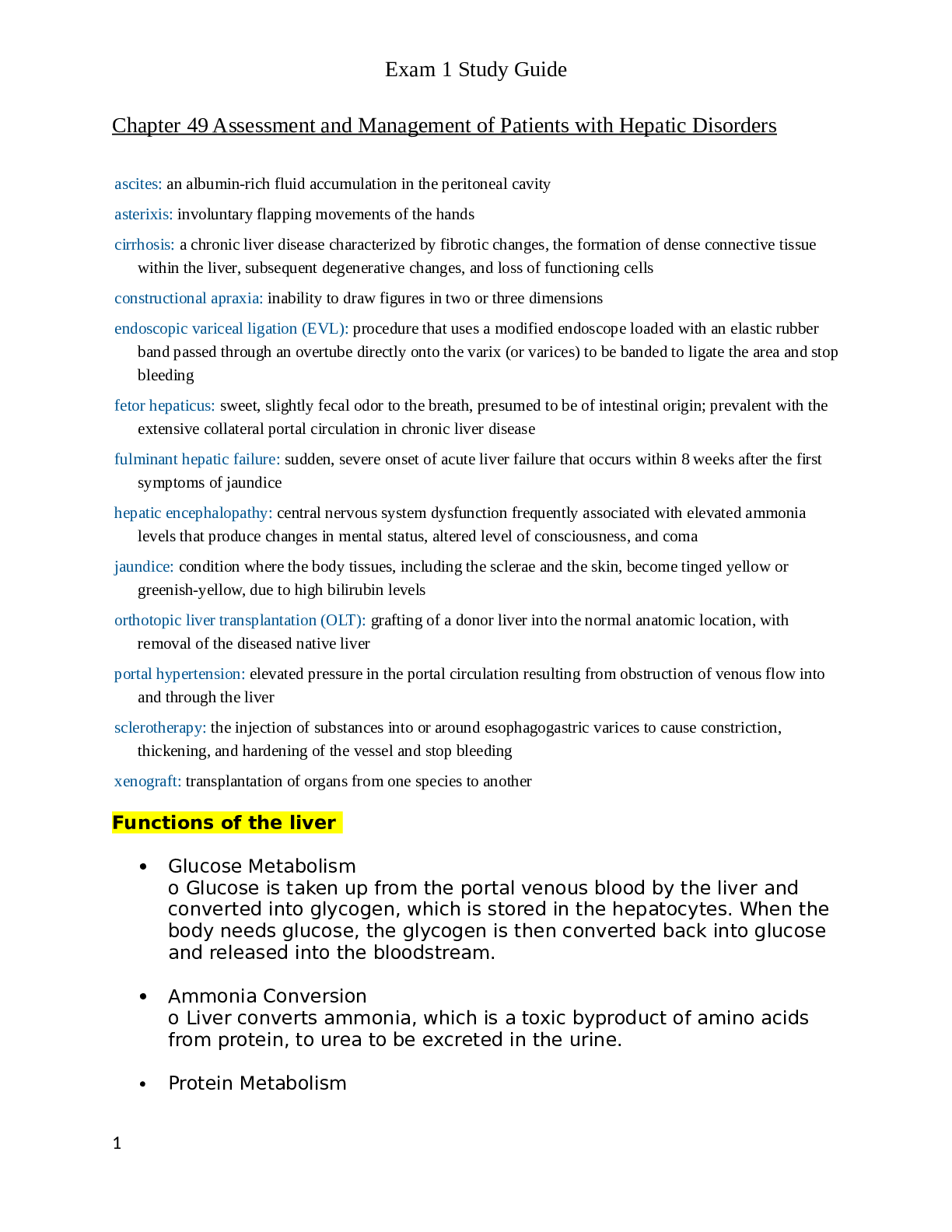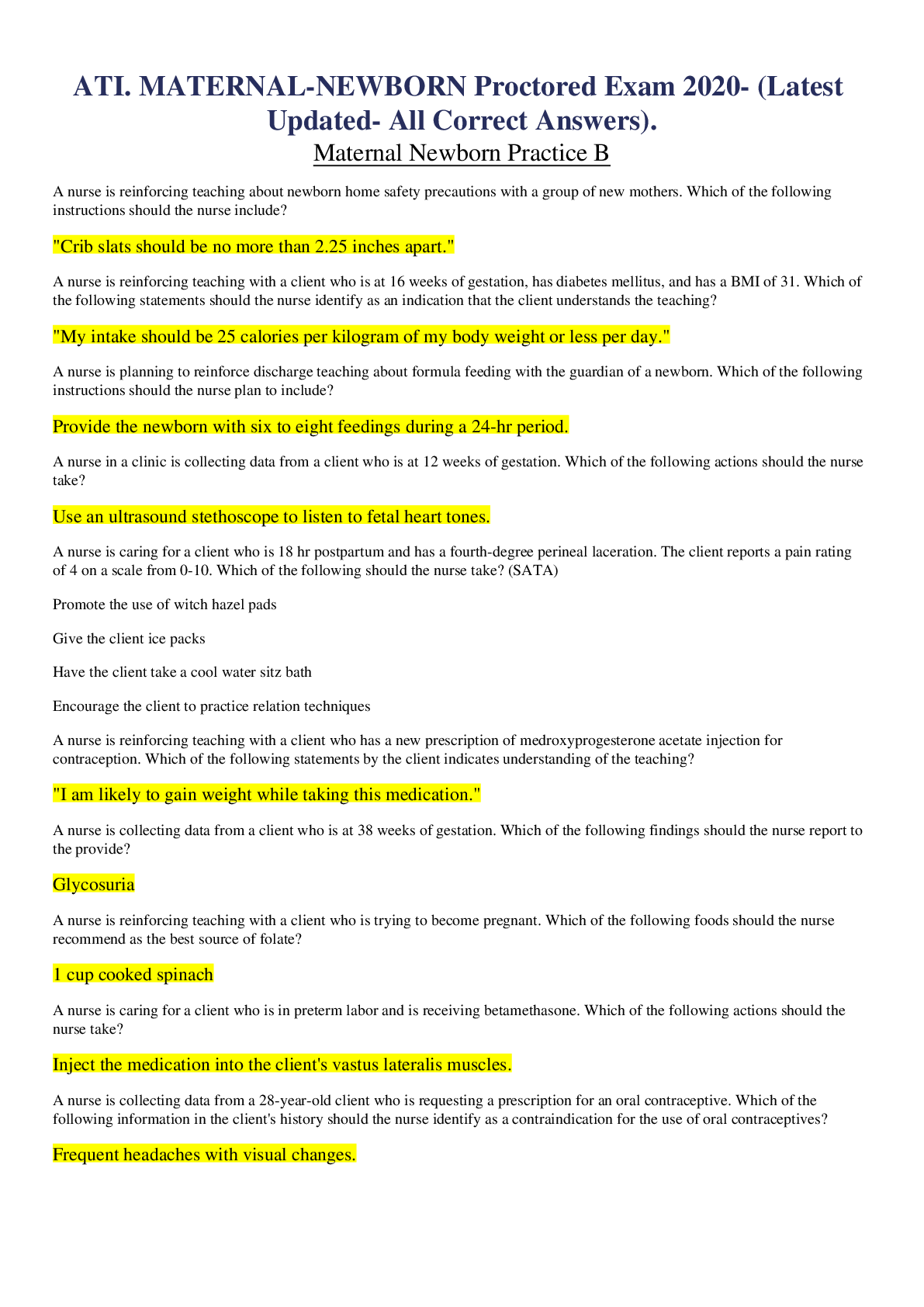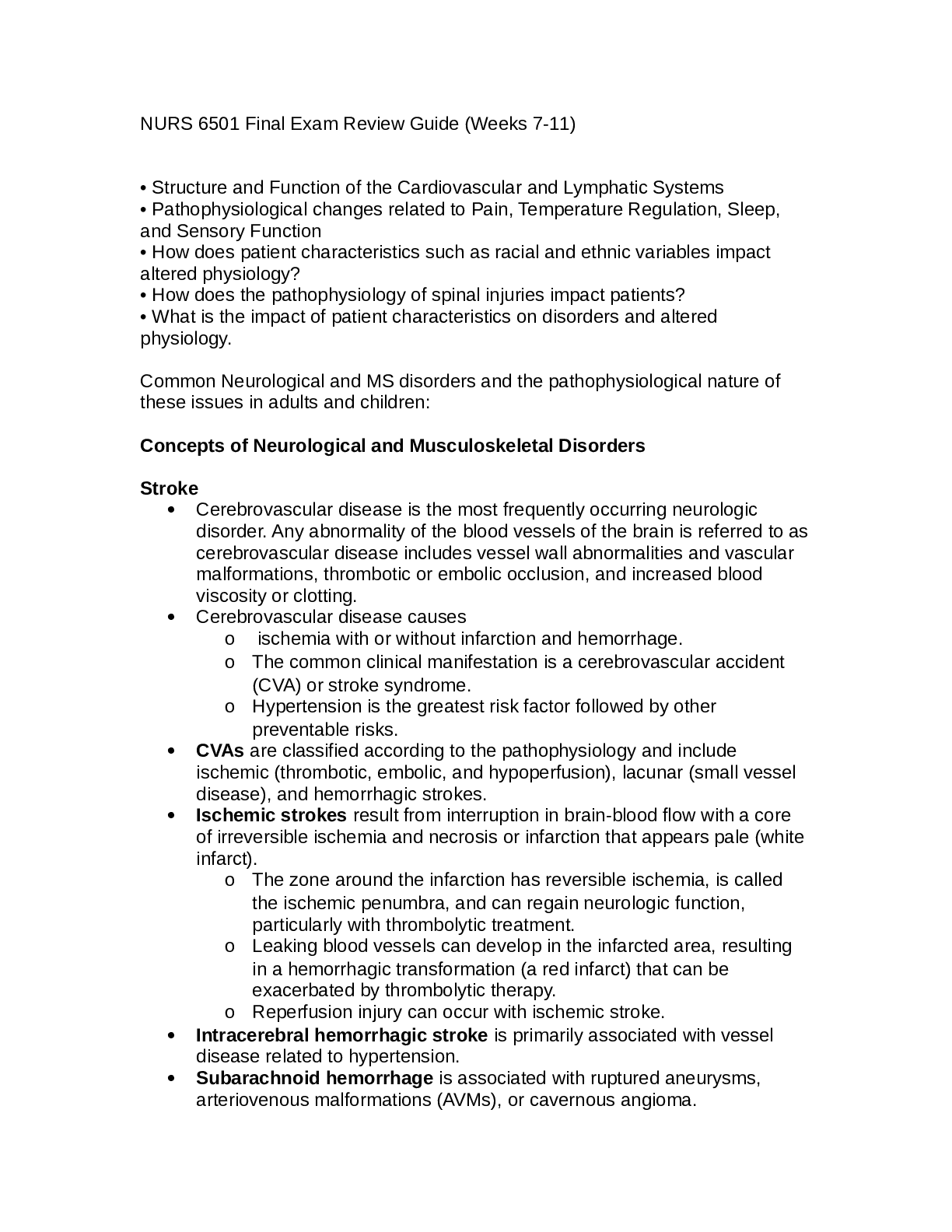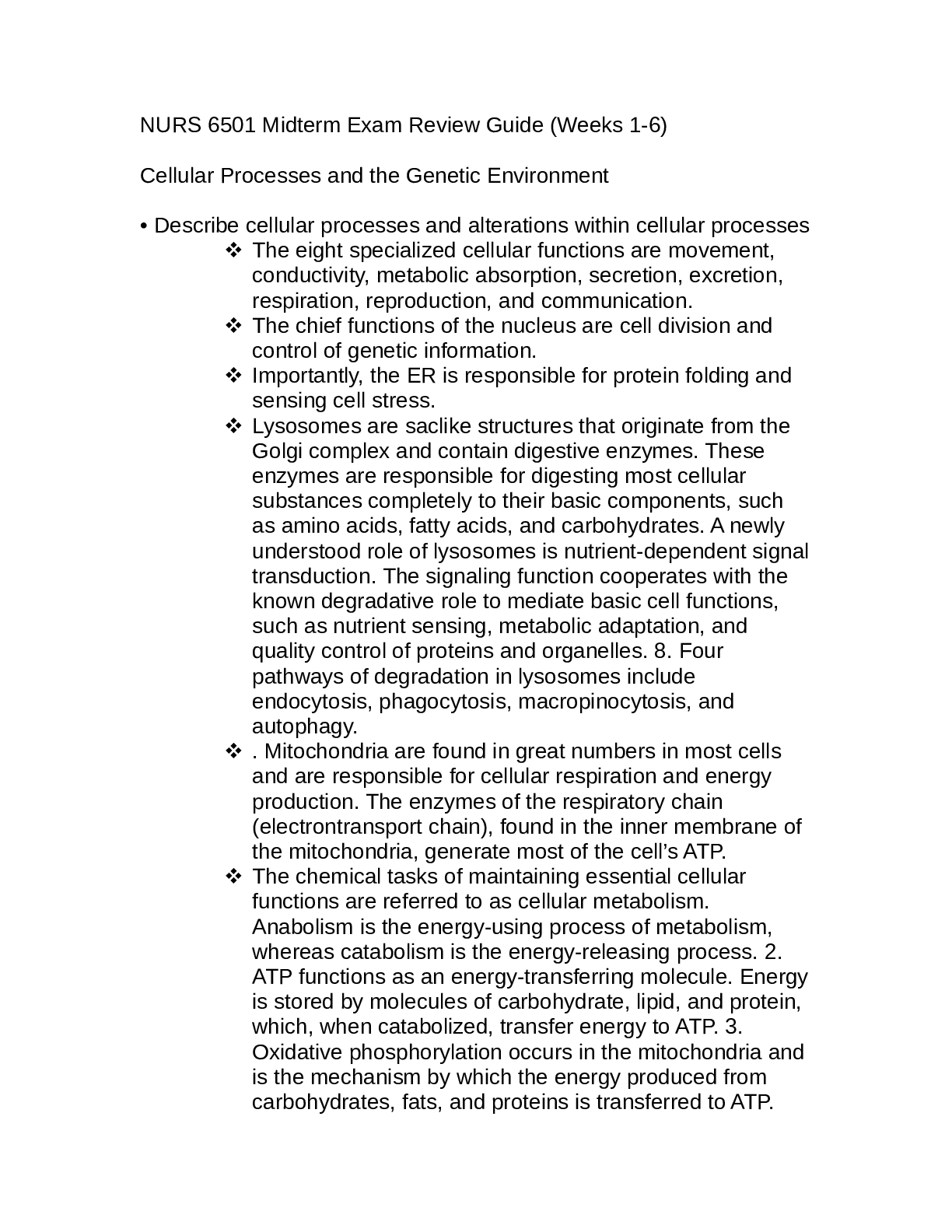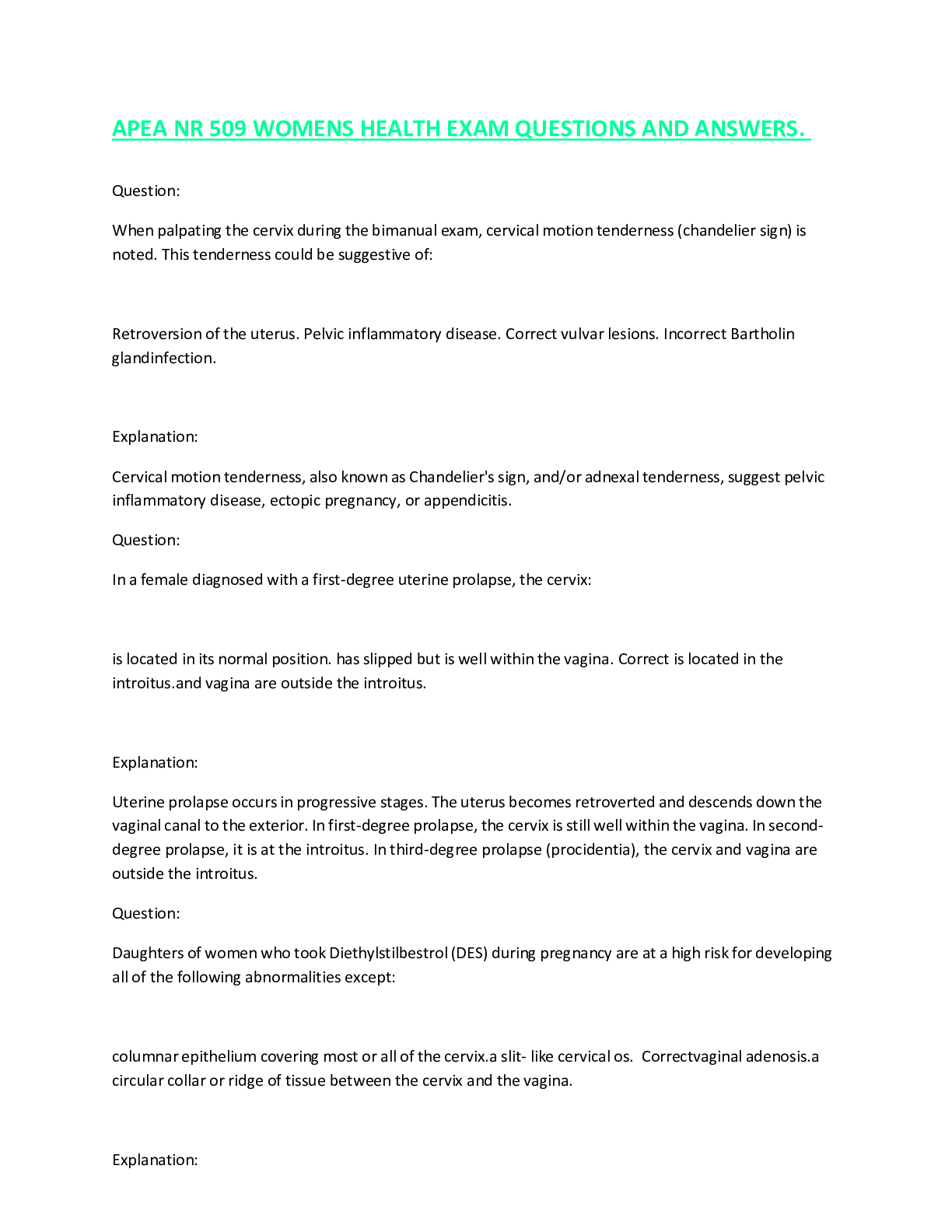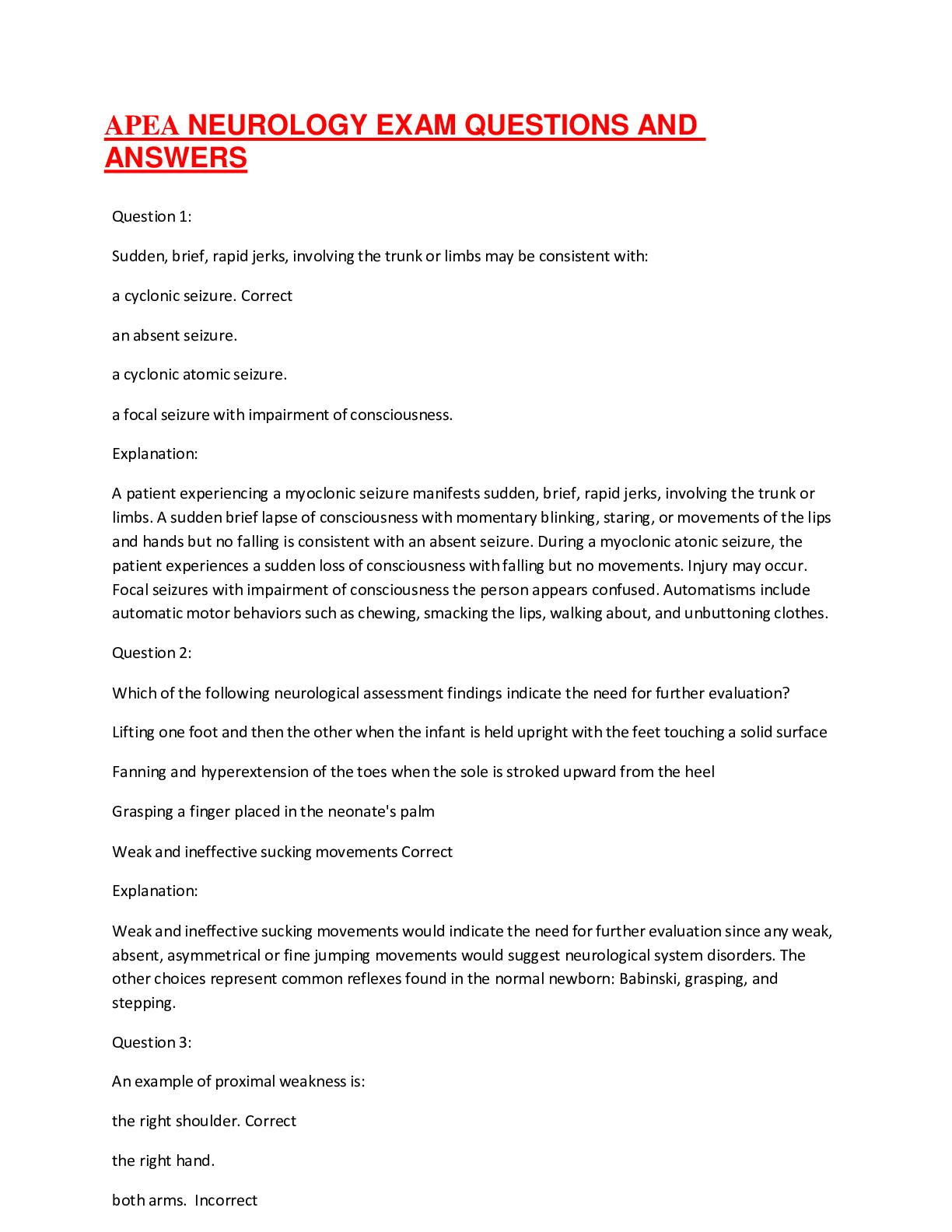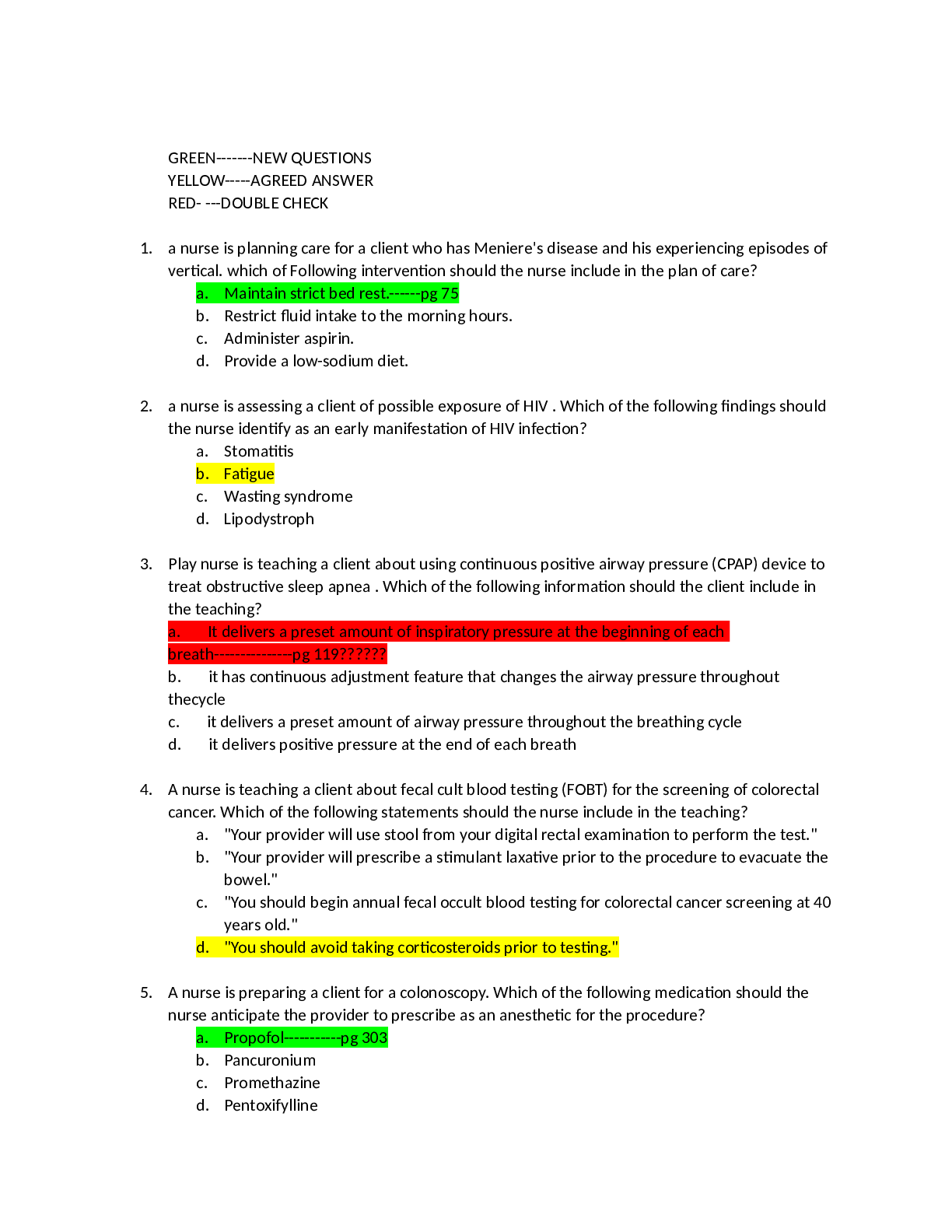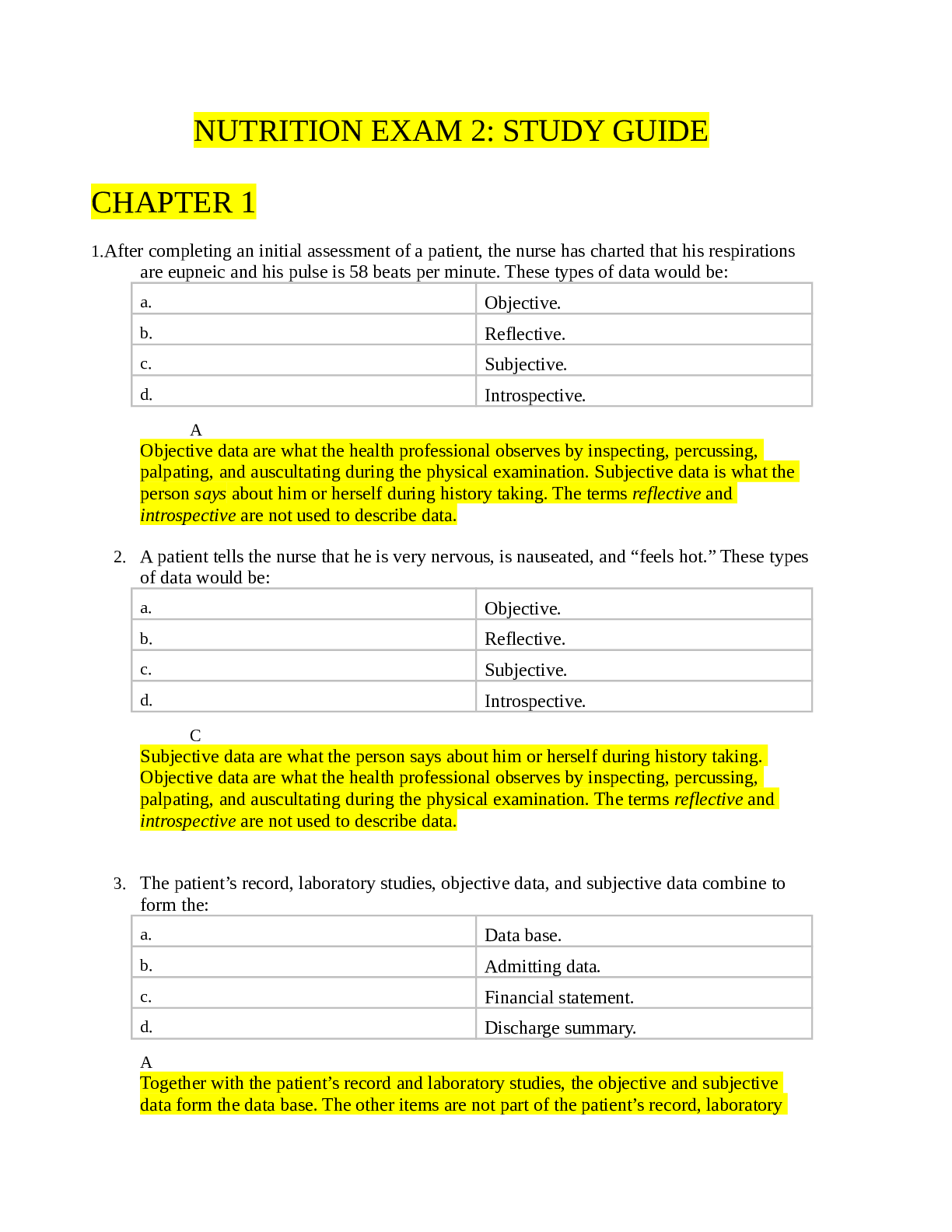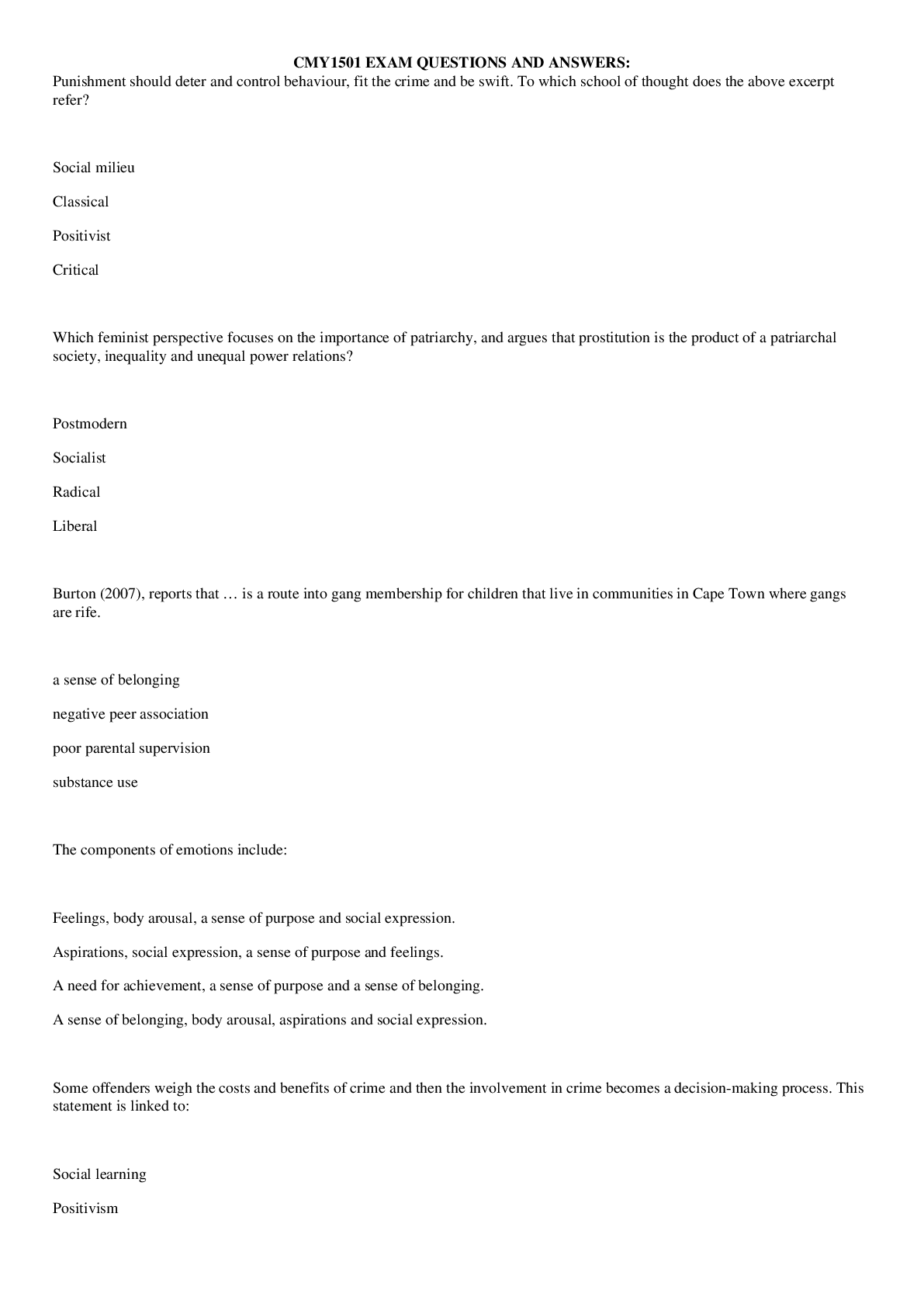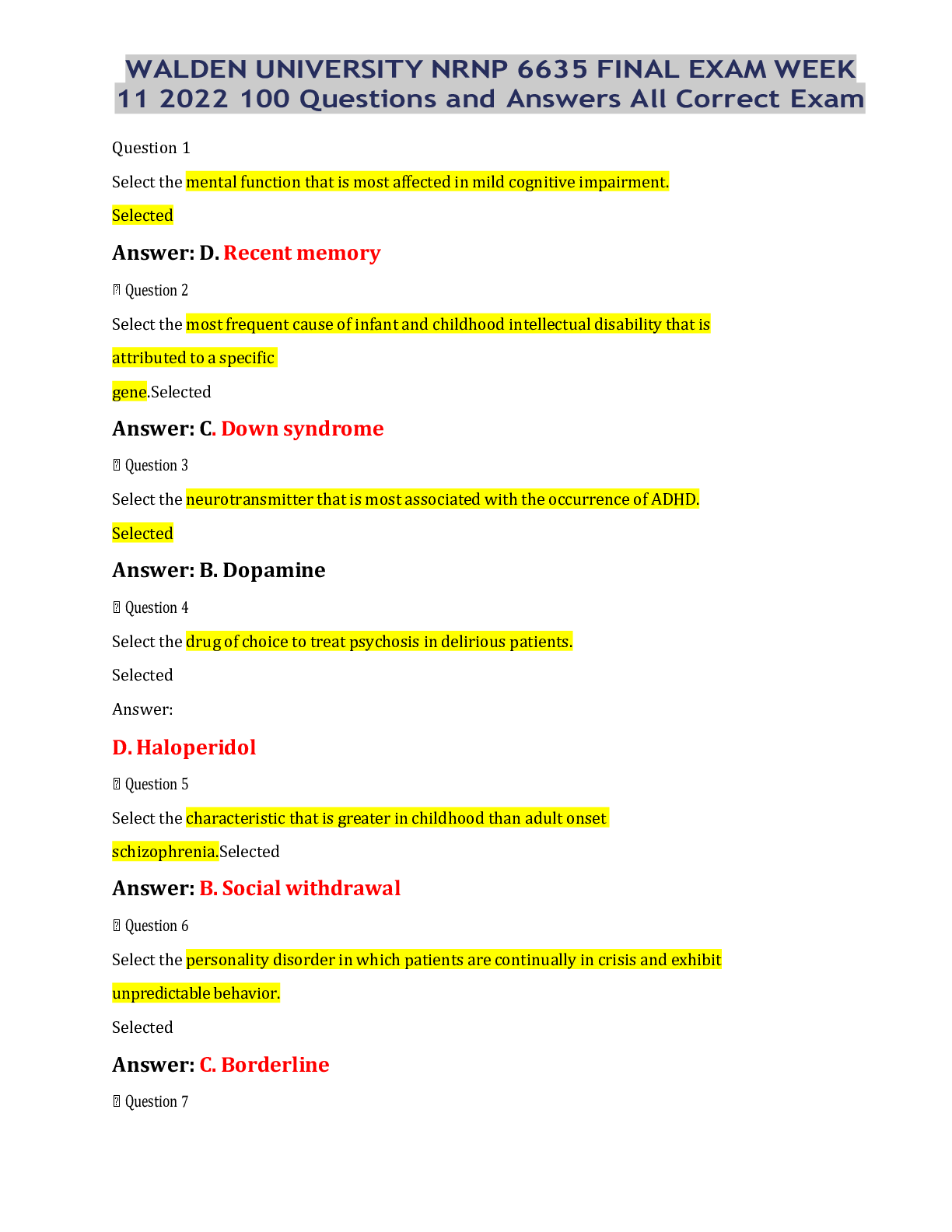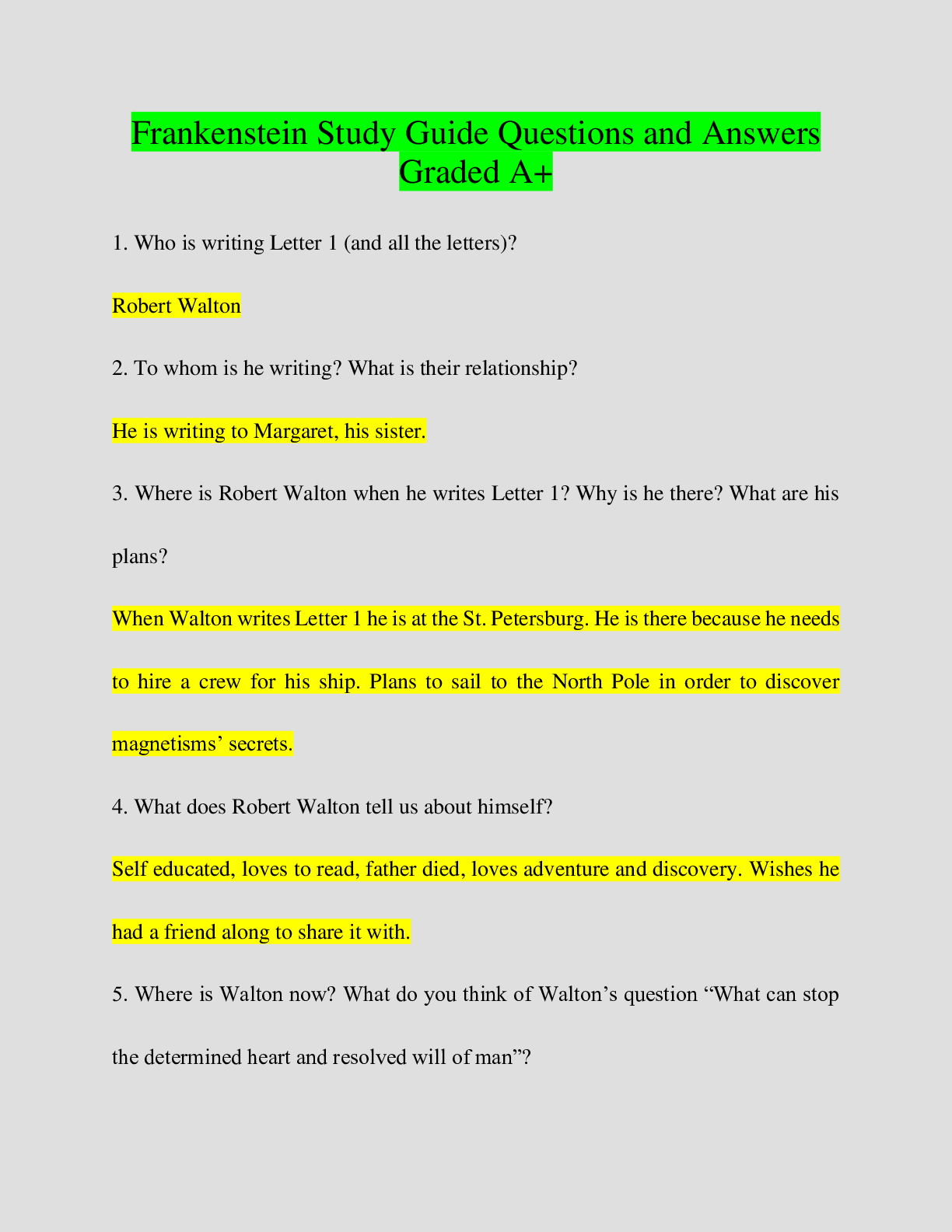*NURSING > EXAM REVIEW > PN 1FINAL STUDY GUIDE QUESTIONS AND ANSWERS ALL ARE CORRECTLY DONE 2021 (All)
PN 1FINAL STUDY GUIDE QUESTIONS AND ANSWERS ALL ARE CORRECTLY DONE 2021
Document Content and Description Below
PN 1FINAL STUDY GUIDE QUESTIONS AND ANSWERS ALL ARE CORRECTLY DONE Your client has had an arthroplasty two days ago and has required pain medication every four hours. What consideration is given to... the use of opioids and immobility in a post-surgical client? a. Decrease peristalsis and can cause severe constipation b. Constipation can cause impaction 2. What is the term for a surgical removal and replacement of a joint? a. arthroplasty 3. Although this arthritis can occur in children, it often strikes at the age of 30-40 years of age. When the immune system attacks it's own tissues, causing red and painful joints it is called which of the following? 4. In order to achieve balance, body mass must be distributed around which point? a. At the waist or midline 5. After caring for a client on contact precautions, the nurse removes PPE within the room and washes hands because of which of the following? a. If her close are contaminated, she keeps the bacteria in the room and prevents the spread of it. 6. Healing time of a simple fracture is 8-12 weeks. During this time what cell reshapes or remodels the mending bone? a. Osteoblasts blast away the old bone, osteoclasts cleans the new bone 7. Which of the following is true regarding standard infection control precautions? a. Standard infection precaution is used for every person that you are treating 8. A client in the emergency room is angry, yelling, cursing, and waving his arms, when the nurse comes into the room. Which action by the nurse is advisable? a. Stand between the patient and the door, try to talk in a calming manner 9. Which PPE is worn when taking a blood glucose sample from an AIDS client? a. gloves 10. The nurse prepares to dispose of stomach contents collected in a suction canister. Which PPE should be worn? a. Face mask/ eye protection, gloves 11. The client in the above question, admits the APAP is not working for her arthritis pain. She tells you that she takes "just two more at midnight". Is this appropriate considering this client also has liver disease? 12. Which is the most commonly reported incident in the hospital? a. UTI 13. An 82 yr old client is unsteady on her feet when walking about the room. She reports feeling a little sore but has no complaints of weakness. What is the appropriate piece of equipment to use when helping her ambulate? a. Gait belt 14. The body's inability to secrete uric acid can often cause an agonizingly painful attack affecting one joint (often seen at the great toe) is called? a. Gout 15. Clients with impaired mobility are at risk for which condition? a. Pressure ulcers/ muscular atrophy 16. Clients have the right to refuse medically necessary treatments if they posess which of the following? 17. Which of the following describes Paget's disease of the bone? 18. You are the triage nurse in the ER and you patient presents with excruciating leg pain. You happen to notice the bone extending out of the leg. This kind of fracture is called which of the following? a. Compound fracture 19. Your client has an obvious dislocation of the shoulder joint. Which intervention would be the first priority? a. Pain medication, prevent it from moving 20. Using the 5 rights of medication administration provides which of the following? a. Right dose, right medication, right route, right time, right patient 21. In the hospital setting, a client with a history of falling continually attempts to get out of bed unassisted despite frequent reminders to call for help first. Which action should the nurse take first to assure safety? a. Schedule regular frequent checks on patient 22. Keeping a dementia client from wandering out of their room can be more easily obtained by which intervention? 23. Your client takes 1000 mg of APAP three times a day. Tablets are available in 500 mg increments. How many tablets does your client take in a day? a. 6 24. Despite less-restrictive interventions, a client's behavior escalates, requiring emergency application of restraints. Which of the following must the nurse do to ensure client safety in this situation? a. Provide food, water, can easily remove if needed 25. This condition may cause elderly clients to fall related to frail bones a. osteoporosis 26. Your client returns from surgery where they were given general anesthesia. The surgery performed will cause this client to remain immobile for several days. Because of this the nurse knows to encourage the client to do which of the following? a. Be repositioned every 2 hours, have nurse do passive exercises 27. Bones are connected to bone by which of the following a. ligament 28. The 1996 act known as HIPAA is defined as which of the following? 29. Muscles are connected to bones by which of the following? a. tendon 30. Which of the following describes arthroscopy? a. Going in to look at the joint with camera 31. What type of client has a greater risk from steroid use for rheumatoid arthritis? 32. Which is the correct name for the bone cell that builds bone for repair? 33. The nurse prepares to complete discharge teaching for home safety. Which of the following applies to home teaching? a. Remove rugs, nothing on the floor 34. Elderly patients tend to lose their confidence in walking related to balance issues and fear of falling. To promote safer mobility, the nurse might offer which of the following interventions? a. Assistance while walking, home safety tips such as no rugs in the house, pick everything off the floor, use machines to assist to prevent injury 35. What would be the most appropriate goal for a frail, elderly client with a nursing diagnosis of "Risk for Injury" after hip surgery? a. Assistance while standing, 36. How many milliliters are in an ounce? a. 30ml/ounce 37. Your client has had a motor vehicle accident and wakes up after having surgery to repair a severly fractured leg. He is somewhat upset to find pins sticking through his leg in a metal apparatus. You calm you client by explaining they had an ORIF. What does that acronym mean? a. Open reduction, internal fixation 38. Your client is getting discharged with a lower leg cast. To ensure home safety, your teaching should include which of the following? a. How to use crutches, 3 point, 4 point 39. Teenagers are often diagnosed with this musculo-skeletal disorder that has a "S" shaped curve in the spine. a. scoliosis 40. Increased softening of the bone resulting from a gradual decrease in the rate of bone formation is called 41. A biohazard bag is used when the contaminant is which of the following? a. Blood 42. A nurse has found her client on the floor. He requests to be lifted under his arms to assist him back to bed. What action is the most likely to eliminate back injuries to the staff? a. Use mechanical machines to decrease injury 43. What is the exam performed to determine the amount of bone loss a client may have? a. Bone density scan 44. The ANA Code of Ethics for Nurses provides which of the following? 45. Osteoarthritis is most prevalent in the aged because it is considered which of the following? a. Inflammation of the bones, decrease calcium absorbed in the body, most common in women after menopause 46. Which aspect of restraints can the nurse delegate to the nursing assistive personnel? a. Losening restraints as needed 47. Mr. Strong, Code Blue, Code Red, missing person, are all examples of which safety precaution? 48. What chemical helps improve the absorption of calcium in the bone? a. Vitamin D 49. What is the best practice for the nurse that notices an IV pump with a cracked electrical cord? a. When in doubt throw it out 50. Beneficence is the ethical principle that describes which of the following? a. Benefit for all Objectives Chapter 1: (23) - Describe the interventions to prevent falls within the healthcare facility. - Describe the safety hazards within the home environment and interventions to prevent injuries. - Verbalize understanding proper use of restraints. - Describe the hazards to health care workers and the interventions to prevent injuries. Chapter 2: (33) - Describe the physiological process involved in the maintenance and restoration of health and wellness. - Evaluate the need for mobility to promote patient safety and Health. - Demonstrate the proper communication techniques to promote patient safety and care. Chapter 3: (29-30) - Describe the physiological process involved in the maintenance and restoration of health and wellness. - Describe nursing interventions that promote normal bowel and urinary elimination. - Identify nursing diagnosis associated with altered urinary elimination. Chapter 4: (42-43) - Discuss the rationale for evidence-based practice. - Define evidence-based practice. - Describe common ethical issues that might concern nurses caring for their patients in different health care settings. - Explain how the nursing process influences clinical judgment while care for your patient across the lifespan. Chapter 5: (20-22) - Describe the phases of the operative period. - Apply the nursing process to develop a care plan for a patient undergoing an operative procedure. - Evaluate the intraoperative complications and interventions for management of care. - Describe the ethical considerations within the intraoperative setting. - Identify patient safety concerns within the intraoperative setting. Chapter 6: (Med Surg 41) - Describe the physiological process involved in the maintenance and restoration of health and wellness. - Describe the different types of Immunity. - Identify how stress and gender can affect the immune system. Chapter 7: (22,26) - Describe the physiological process involved in the maintenance and restoration of health and wellness. - Describe the processes involved in primary, secondary, and tertiary defenses. - Demonstrate the use of standard and sterile precautions to prevent infection. - Explain why multiple-drug-resistant pathogens aid in the spread of infections. Chapter 8: (39) - Describe the physiological process involved in the maintenance and restoration of health and wellnes. - Describe the body mechanisms for maintaining fluid and electrolyte balance. - Describe the major fluid and electrolyte balance disorders. Chapter 9: (32) - Describe the physiological process involved in the maintenance and restoration of health and wellness. - Evaluate the process of pain management through the use of clinical judgment and the nursing process. - Explain the difference between personal and professional identity in regards to caring for a patient that needs pain management. - Utilize various forms of technology and professional references to support the care of the patient. Chapter 10: (19) - Describe the physiological process involved in the maintenance and restoration of health and wellness. - Discuss what a normal body temperature is and how to measure it. - Describe the nursing interventions for the patient with temperature alterations. - Utilize various forms of technology and professional references to support the care of the patient. The nurse can best minimize the risk for infection when initiating an intravenous site by: B. Effective topical skin preparation D. Gloving for the procedure The nurse instructs a client to use good handwashing and cover her nose and mouth when sneezing. These efforts will reduce others’ exposure to molecules that can elicit an immune response or: D. immunogens. An older adult client tells the nurse that her granddaughter has chickenpox. The client is afraid to visit because she is afraid of getting shingles from her granddaughter. What is the nurse’s best response? B. “If you already had shingles, you cannot get them again.” The nurse is assessing a client for a history of cancer. To aid in this assessment, the nurse can use which of the following words as a mnemonic? A. CAUTION The nurse assesses a cut that is 24 hours old and finds that the site is swollen, red, and tender to the touch. Which cell types are responsible for these assessment findings? B. Basophils and eosinophils The nurse is assessing a client who has a wound on the left calf. Drainage is coming from the wound. What does the nurse tell the client about this finding? A. “Exudate or drainage is a natural occurrence with inflammation.” The nurse is removing personal protective equipment (PPE). Which item should be removed first? B. Gloves While donning sterile gloves, the nurse notices the edges of the glove package are slightly yellow. The yellow area is over 1 inch away from the gloves and only appears to be on the outside of the glove package. What is the best action for the nurse to take at this point? B. Throw the first pair of sterile gloves away and obtain a new pair of sterile gloves. The nurse reads in the medical record that a client has Kussmaul respirations. Which assessment finding is consistent with this condition? A. Deep, rapid respirations The nurse is caring for a postoperative patient who had an open appendectomy. The nurse understands that this patient should have some erythema and edema at the incision site 12 to 24 hours post operation if A. his immune system is functioning properly. The nurse is caring for a patient who was started on intravenous antibiotic therapy earlier in the shift. As the second dose is being infused, the patient reports feeling dizzy and having difficulty breathing and talking. The nurse notes that the patient's respirations are 26 breaths/min with pulse 112 beats/min and weak. The nurse suspects that the patient is experiencing a(n) D. anaphylactic reaction. When turning a client, the nurse notices a reddened area on the coccyx. What skin care interventions should the nurse use on this area? A. Clean the area with mild soap, dry, and add a protective moisturizer. D. Wash the area with an astringent and paint it with povidone-iodine (Betadine). Which client is at greatest risk for dehydration? D. Older adult client with cognitive impairment In order to provide the best intervention for a patient, the nurse is often responsible for obtaining a sample of exudate for culture. This test will identify A. whether a patient has an infection. C. what cells are being utilized by the body to attack an infection. D. what specific type of pathogen is causing an infection. The nurse would perform which action when washing hands as part of medical asepsis before caring for a client in an outpatient clinic? Select all that apply. D. Use a clean paper towel to turn water off. E. Rub vigorously using firm circular motions. During a routine screening, a client has a positive response to intradermal injection of purified protein derivative (PPD or Mantoux test). The nurse draws which conclusion about this result? A. The client is currently infectious with tuberculosis. B. The client tests positively for active tuberculosis. D. The client has been infected with tuberculosis, and has developed a cellular (T cell) response to the tubercle bacillus. Which set of assessment data is consistent for a patient with severe infection that could lead to system failure? B. BP 90/48, P 112 beats/min, RR 26 breaths/min, urine output 240 mL in 24 hr D. BP 152/90, P 52 beats/min, RR 12 breaths/min, urine output 4800 mL in 24 hr What is the most frequent cause of the spread of infection among institutionalized patients? C. Hands of healthcare workers Which client is at highest risk of compromised immunity? A. Client who has just had surgery A client is diagnosed with a bacterial infection. Which of the following is an example of this type of infection? C. Urinary tract infection A client presents with dyspnea, pruritus, and localized swelling of the forearm after being stung by a bee. What is the priority nursing intervention? C. Check the tongue for swelling and listen for stridor A nurse is splashed in the face by body fluid during a procedure. Prioritize the nurse’s actions, listing the most important one first.1. Contact employee health2. Complete an incident report3. Wash the exposed area4. Report to another nurse that she is leaving the immediate area. C. 3, 4, 1, 2 After preparing a client’s skin for insertion of an intravenous catheter, the nurse accidentally touches the skin site with an uncovered finger. Which of the following should the nurse do? A. Cleanse the skin again. The nurse, after reviewing a client’s immunization history, realizes that which of the following pathogen toxoids would not be given to an individual to develop an immune response? C. Snake toxin Which of the following would the nurse identify as age-related changes in immunologic function that occur in the older adult? (Select all that apply.) B. Altered nutrition intake C. Failure of immune system to differentiate self from nonself D. Increased hematuria E. Increased adipose tissue F. Maintenance of function of the B lymphocytes Pressure ulcers are directly caused by which of the following conditions at the site? A. Compromised blood flow A client with hypocalcemia is taking supplemental vitamin D. When the client asks the purpose of this therapy, what explanation should the nurse give? C. Calcium is absorbed in the intestines only under the influence of activated vitamin The nurse is caring for an older postoperative client. Which assessment finding causes the nurse to assess further for a wound infection? B. The client is now confused but was not confused previously. What is the primary goal that the nurse should establish for a patient with an open wound? A. The wound will remain free of infection throughout the healing process. A client begins rapid breathing and demonstrates anxiety after learning of a diagnosis of breast cancer. After a short while, the client complains of tingling lips and fingers. Which of the following should the nurse do to assist this client? C. Help the client slow the respiratory rate or breathe into a paper bag. On admission to the clinic, the nurse notes a moderate amount of serous exudate leaking from the patient's wound. The nurse realizes that this fluid A. contains the materials used by the body in the initial inflammatory response. Which of the following interventions would be appropriate for a client recovering from a splenectomy? A. Assist with ambulation once per shift. B. Medicate for pain. C. Utilize strict infection control techniques. D. Encourage the client to deep breathe and cough every 8 hours. A client is being admitted to a health care facility. Which type of precautions will the nurse implement at this time? D. Standard A 25-year-old client is admitted to a healthcare facility with complaints of fever, vomiting, and watery diarrhea for 2 days. On examination, the client has dry skin, delayed skin turgor, and hypotension. What is the most likely nursing diagnosis? D. Deficient fluid volume A client tells the nurse that he is allergic to Valium because he experienced nausea, vomiting, and dizziness after ingesting. How should the nurse document this information? D. Client experiences nausea, vomiting, and dizziness after ingesting Valium. A patient is being treated with an antibiotic. The nurse explains to the patient that this medication is required for the reduction of inflammation at the injury site because this medication A. will decrease the pain at the site. A patient is diagnosed with a sprain to her right ankle after a fall. The patient asks the nurse about using ice on her injured ankle. The nurse should tell the patient that B. ice should be applied for 15 to 20 minutes every 2 to 3 hours over the next 1 to 2 days. An 82-year-old client is admitted for dehydration. The daughter asks the nurse why this may have happened. The nurse educates the family about how the elderly are at an increased risk for fluid and electrolyte imbalances. What is the best explanation for the risk of this imbalance to the family? C. Decreased thirst sensations A child has scraped his finger on a sharp spot on a shower door edge. The mother would like to use a topical antibiotic to prevent infection. Which agent would the pediatric telephone consultation nurse recommend? A. Bacitracin (Baciguent Topical) B. Malathion (Ovide Lotion) C. Ketoconazole (Nizoral) D. Mafenide (Sulfamylon) A client is admitted to the emergency department with a 3-inch laceration over the left eye. The nurse should assess for which priority factor related to risk of infection before beginning drug therapy to prevent infection? B. The date of the client’s last tetanus vaccine The nurse has telephone messages from four patients who requested information and assistance. Which one should the nurse refer to a social worker or community agency first? D. "I ran out of money and am cutting my insulin dose in half." A client enters the emergency department (ED) with an injury to the wrist. In assessment, the nurse notes that the area is red, warm, and edematous. What is the nurse’s best action? B. Inject pain medication directly at the site. D. Assess circulation and elevate the extremity. While assessing a client’s intravenous (IV) line, the nurse notes that the area is swollen, cool, pale, and causes the client discomfort. What complication should the nurse document? A. Infiltration B. Phlebitis C. Infection D. Air embolism Which statements said by patients indicate that the nurse's teaching regarding prevention of acid-base imbalances is successful? (Select all that apply.) B. "I shall take my insulin on time every day." C. "My aspirin is on a high shelf away from children." D. "I have reliable transportation to dialysis sessions." A nurse is instructing her patient with ulcerative colitis regarding the need to avoid enteric coated medications. The nurse knows that the patient understands the reason for this teaching when he states which of the following? C. "Enteric coated medications are absorbed lower in the digestive tract and can be irritating to my intestines or inadequately absorbed by my inflamed tissue." A client has a reduction in immune function. What is the nurse’s priority action for this client? D. Wash hands before entering the room. Which body fluid lies in the spaces between the body cells? A. Interstitial B. Intracellular C. Intravascular D. Transcellular The nurse would expect that a client diagnosed with arthritis will be prescribed which of the following medications? A. Albuterol B. Furosemide C. Ibuprofen D. Nortriptyline A client is complaining of numbness and tingling around the intravenous infusion catheter. Which of the following should the nurse do? A. Apply heat. B. Remove the cannula. D. Slow the intravenous infusion rate. The nurse is working on a plan of care with her patient which includes turning and positioning and adequate nutrition to help the patient maintain intact skin integrity. The nurse helps the patient to realize that this breaks the chain of infection by eliminating a C. portal of entry. [Show More]
Last updated: 1 year ago
Preview 1 out of 12 pages

Reviews( 0 )
Document information
Connected school, study & course
About the document
Uploaded On
Jan 27, 2021
Number of pages
12
Written in
Additional information
This document has been written for:
Uploaded
Jan 27, 2021
Downloads
0
Views
42



.png)
